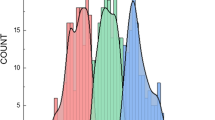Abstract
The conditioned place preference (CPP) paradigm was used in order to assess the reinforcing actions of nicotine in rats. Subjects were tested in “unbiased” two-compartment shuttle boxes, so-called because neither compartment was consistently preferred prior to drug conditioning. In the first experiment, subjects that were initially drug naive showed neither a preference nor an aversion to the compartment that had been paired on four occasions with injection of nicotine (0.2–0.8 mg/kg SC); a similar result occurred in another group given daily injections of nicotine in the home cage prior to the experiment. In a second experiment, nicotine (0.4, 0.8 mg/kg SC) again failed to produce a CPP, whereas marked CPPs were seen in parallel groups of rats tested with either d-amphetamine or methylphenidate. Although nicotine has been reported to produce conditioned place preference, the present results suggest that it is not a robust phenomenon.
Similar content being viewed by others
References
Beckett AH, Gorrod JW, Jenner P (1971) The effect of smoking on nicotine metabolism in vivo in man. J Pharm Pharmacol 23:62S–67S
Bozarth MA, Wise RA (1981) Heroin reward is dependent on a dopaminergic substrate. Life Sci 29:1881–1886
Clarke PBS (1984) Chronic central nicotinic blockade after a single injection of the bisquaternary ganglion blocking drug chlorisondamine. Br J Pharmacol 83:527–535
Clarke PBS, Kumar R (1983a) The effects of nicotine on locomotor activity in non-tolerant and tolerant rats. Br J Pharmacol 78:329–337
Clarke PBS, Kumar R (1983b) Characterisation of the locomotor stimulant action of nicotine in tolerant rats. Br J Pharmacol 80:587–594
Clarke PBS, Kumar R (1984) Some effects of nicotine on food and water intake in undeprived rats. Br J Pharmacol 82:233–239
Cox BM, Goldstein A, Nelson WT (1984) Nicotine self-administration in rats. Br J Pharmacol 83:49–55
Deneau GA, Inoki R (1967) Nicotine self-administration in monkeys. Ann NY Acad Sci 142:277–279
Dunnett CW (1955) A multiple comparison procedure for comparing several treatments with a control. J Am Stat Assoc 50:1096–1121
Fudala PJ, Iwamoto ET (1985) Nicotine-induced conditioned place preference (CPP): dose-response, temporal requirements and lack of tolerance development. Soc Neurosci Abstr 11(2):378.8
Fudala PJ, Teoh KW, Iwamoto ET (1985) Pharmacologic characterization of nicotine-induced conditioned place preference. Pharmacol Biochem Behav 22:237–241
Goldberg SR, Spealman RD, Goldberg DM (1981) Persistent high rate behavior maintained by intravenous self-administration of nicotine. Science 214(4520):573–575
Henningfield JE, Goldberg SR (1983) Control of behavior by intravenous nicotine injections in human subjects. Pharmacol Biochem Behav 19:1021–1026
Kirk RE (1968) Experimental design: Procedures for the behavioral sciences. Brooks/Cole, Belmont, CA, USA
Kumar R (1972) Morphine dependence in rats: secondary reinforcement from environmental stimuli. Psychopharmacology 25:332–338
Kumar R, Pratt JA, Stolerman IP (1983) Characteristics of conditioned taste aversion produced by nicotine in rats. Br J Pharmacol 79:245–253
Laffan RJ, Borison HL (1957) Emetic action of nicotine and lobeline. J Pharmacol Exp Ther 121:468–476
Mithani S, Martin-Iverson MT, Phillips AG, Fibiger HC (1986) The effects of haloperidol on amphetamine- and methylphenidate-induced conditioned place preferences and locomotor activity. Psychopharmacology 90:247–252
Mucha RF, Iversen SD (1984) Reinforcing properties of morphine and naloxone revealed by conditioned place preferences: a procedural examination. Psychopharmacology 82:241–247
Phillips AG, LePiane FG (1980) Reinforcing effects of morphine microinjection into the ventral tegmental area. Pharmacol Biochem Behav 12:965–968
Risner ME, Goldberg SR (1983) A comparison of nicotine and cocaine self-administration in the dog: fixed-ratio and progressive-ratio schedules of intravenous drug infusion. J Pharmacol Exp Ther 224:319–326
Sherman JE, Roberts T, Roskam SE, Holman EW (1980) Temporal properties of the rewarding and aversive effects of amphetamine in rats. Pharmacol Biochem Behav 13:597–599
SPSSX User's Guide, SPSS Inc., Chicago, IL
Spyraki C, Fibiger HC, Phillips AG (1982a) Cocaine-induced place preference conditioning: lack of effects of neuroleptics and 6-hydroxydopamine lesions. Brain Res 253:195–203
Spyraki C, Fibiger HC, Phillips AG (1982b) Dopaminergic substrates of amphetamine-induced place preference conditioning. Brain Res 253:185–193
Stolerman IP (1986) Psychopharmacology of nicotine: stimulus effects and receptor mechanisms. In: Iversen LL, Iversen SD, Snyder SH (eds) Handbook of psychopharmacology, vol 19. Plenum, New York (in press)
Stolerman IP, D'Mello DG (1981) Oral self-administration and the relevance of conditioned taste aversions. In: Thompson T, Dews PB, McKim WA (eds) Advances in behavioural pharmacology, vol 3. Academic, New York, pp 169–214
Author information
Authors and Affiliations
Rights and permissions
About this article
Cite this article
Clarke, P.B.S., Fibiger, H.C. Apparent absence of nicotine-induced conditioned place preference in rats. Psychopharmacology 92, 84–88 (1987). https://doi.org/10.1007/BF00215484
Received:
Revised:
Issue Date:
DOI: https://doi.org/10.1007/BF00215484




